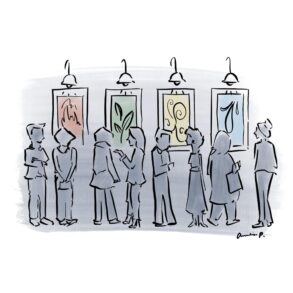
If you’ve kept an eye on the abundant news in the crypto market, you’re probably familiar with the current price rally triggered in part by the presidential elections in the U.S. in November.
The crypto maker leader, Bitcoin, almost hit the $100K milestone, taking more cryptos up with it as new waves of investors shifted their attention to the crypto sector. Some cryptocurrencies suddenly began looking like very promising investments – with a focus on a few of them. Among these, the live Render crypto price prediction indicates that the artist’s network is one of the hot keepers of the moment. The fact that it has to break some levels to reattain its ATH means that the asset is still modestly priced, permitting both rookies and seasoned investors to leverage it.
A less-known side of Render is that it is the leading and largest network for 3D assets and digital content creation. It helps numerous creators in the digital art field create visual content that would otherwise be very costly and of lower quality through its core function – GPU rendering. Why should you care and how can this impact the market and the prices? Even better, could you make use of the network’s offerings one day?
Frankly, one important aspect that can fuel or destroy cryptos is their functionalities. Unlike Bitcoin, which doesn’t do more than serve as a store of value and money transfer alternative, Render has actual, real-world, and sought-after functionalities. This is a good thing for its community and those with RNDR, the network’s token, in their portfolios. It has better chances of flourishing compared to many other cryptos. So, what’s this miraculous technology that supercharges artists’ workflows?
A few introductory words
Render rose as the guiding light of ground-breaking initiatives, making use of the power of decentralized computing and Ethereum blockchain to reshape how artists transform their ideas into realities. As the year’s final draws near, a great way to give this network its props for innovating the world is to recall its quest for betterment. If you came late to the game, noting that the network laid the foundation for an environmentally oriented charity to raise an astronomical 6.6MN dollars that would later be used to offset the climate impact and change is another valuable info.
The platform helping important donors contribute to some of the world’s most concerning causes deserves its adnomination as the artist’s platform, as well as its high position in the ranks of projects with good real-world scopes.
Render’s recent milestones
This year, Render went through a massive update that gave rise to features such as comp shaders, custom OSL AOV posts, per-light denoising, as well as rendering across CUDA and Metal devices. The year was marked by the debut of Octane 2024 – the first and swiftest unbiased GPU render engine to date.
Moreover, the Render Network Foundation and Blender Foundation shook hands in what’s considered to be one of the most transformative moves for interested artists who use the network’s services. The project enables access to high-fidelity rendering for more than 2MN Blender users, offering them the decentralized network’s computational power for a price that’s anticipated to drop.
The project also started to support jobs a Stable Diffusion, establishing a new milestone for the field of AI-based content creation. This fusion allows for AI rendering and training jobs, emphasizing the network’s adjustability in the face of changing tech trends, like the developing generative AI that is reshaping digital artwork.
Lastly, the network augmented its compatibility with other projects, laying the foundation for perfect integration with Cinema 4D files. The network also offers support for other rendering engines, such as Redshift. This move demonstrates the network’s solid commitment to revolutionizing digital artistry and bringing it closer to anyone flirting with the sector, proposing new means to create art. The last move reconfirms how the network prioritizes artists’ great user experience, bringing in more ways to leverage the proposed resources while still sticking with their favorite way of working.
The network’s ethos
The philosophy guiding development initiatives at Render boils down to the community’s ambitions and implications. The community has been actively involved in shaping the platform’s trajectory via the Render Network Proposal (RNP) system. For example, a project that sparked optimism was the suggestion to improve the network’s tokeneconomics and associate the digital sphere with the creative one. This mirrors the network’s commitment to making it from a creatives’ point of view, helping creatives at the end of the day.
Urbach, Render Network’s founder, and OTOY’s CEO, recently offered some insights into the revolutionary feats their cooperative tech-enabled during the short film production honoring Star Trek’s 30th anniversary—” 765874 Unification.” The movie’s production emphasized the Network’s ability to democratize first-rate content creation, facilitating the development of mouth-opening visual effects for a fraction of the costs that other productions spend.
What lies ahead
As the year draws to an end, the community supporting the Render Network keeps an eye out for upcoming proposals and initiatives. The Render Network Foundation brings forth impressive projects, with the talk revolving around focusing on the proposals that are able to further augment the network’s functionality and reach from a financial point of view. The financial promise makes it clear that the Render Network’s implication in decentralized computing is tremendous, and the community’s confidence stands as a testimonial.
Last words
In the ever-rising field of digital content creation, marked by exigent expectations for top-quality graphics and rendering, a ground-breaking platform serves as a beacon of hope, namely the Render Network. This decentralized network goes beyond being just a tool to create 2D and 3D artworks and animations. It’s now a far-seeing leap into a future where executing GPU-based tasks, specifically in the sectors of AI, 3D, rendering, and so on, become easier, cheaper, more efficient, and more inclusive.
This post was originally published on this site be sure to check out more of their content

